Chhatrapati Shivaji Maharaj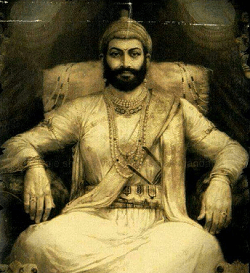
Western India's Maratha Empire was founded by Chatrapati Shivaji Maharaj. He is regarded as one of the greatest fighters of his era, and even now, stories of his exploits are still spoken of as legends. Shivaji expelled a portion of the waning Adilshahi sultanate of Bijapur with his courage and extraordinary administrative skills. Finally, it resulted in the founding of the Maratha Empire. After establishing his standards, Shivaji carried out a smart and reasonable organisation with the aid of a restrained military and a well-established managerial structure. Shivaji is renowned for his innovative military tactics that rely on unconventional methods and use crucial factors like geology, speed, and shock to conquer his more exceptional opponents. Adolescence and Early Life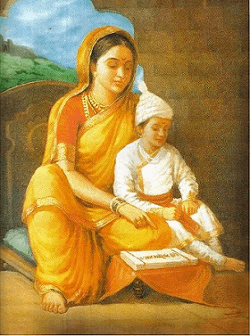
On February 19, 1630, Shivaji Bhosle was born to Shahaji Bhosle and Jijabai in the Shivneri stronghold, adjacent to the city of Junnar in the Pune region. Shivaji's father, Shahaji, was to serve as a commander for the Bijapuri Sultanate, a three-sided alliance comprising Bijapur, Ahmednagar, and Golconda. Additionally, he owned a Jaigirdari, close to Pune. Jijabai, Shivaji's mother, was a fiercely austere woman and the young daughter of Sindkhed founder Lakhujirao Jadhav. Shivaji was extremely close to his mother, who gave him a strong sense of good and bad. 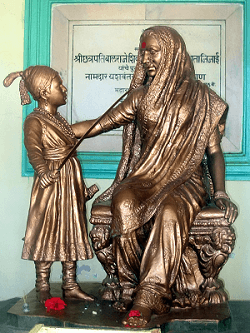
A small chamber of priests was tasked with overseeing Shivaji's education because Shahaji expended a significant amount of his energy outside of Pune. The panel was comprised of Peshwa (Shamrao Nilkanth), a Mazumdar (Balkrishna Pant), a Sabnis (Raghunath Ballal), a Dabir (Sonopant), and a principal instructor (Dadoji Konddeo). It was decided that Baji Pasalkar and Kanhoji Jedhe would train Shivaji in military and combative skills. In 1640, Shivaji married Saibai Nimbalkar. Starting at a very young age, Shivaji became a born leader. Being an active outdoorsman, he explored the Sahayadri Mountains that encircled the Shivneri fortresses and learned pretty much everything there was to know. He had assembled a group of tenacious fighters from the Maval area when he was fifteen, and they later supported his early victories. Conflicts with Bijapur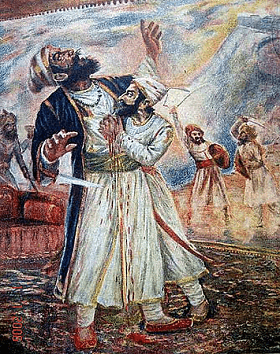
By 1645, Shivaji had obtained control of a number of important areas in the vicinity of Pune from the Bijapur Sultanate, including Singhagarh and Purandar, as well as Torna from Inayat Khan, Chakan from the FirangojiNarsala, and Kondana from Adil Shahi Governor. Following his success, Mohammed Adil Shah, who made the request to imprison Shahaji in 1648, saw him as a threat. Delivering Shahaji was contingent upon Shivaji remaining anonymous and prevented from gaining more victories. After Shahaji's death in 1665, Shivaji continued his victories by acquiring the Javali valley from Bijapuri jaigirdaar Chandrarao More. Shivaji was put down by Afzal Khan, a powerful general dispatched by Mohammed Adil Shah. On November 10, 1659, the two had a private meeting to discuss the terms of the trade. Shivaji arrived beforehand wearing a shield and concealing a metal tiger hook since he assumed it was a snare. Afzal Khan attacked Shivaji with a knife at that time, but Shivaji was saved by his reinforcement. In response, Shivaji attacked Afzal Khan with the tiger's paw, killing him. He asked for the ability to launch an assault against the Bijapuri contingents that lacked a leader. In the Battle of Pratapgarh, where the Maratha forces slaughtered almost 3000 Bijapuri soldiers, victory was easy for Shivaji. The following time Shivaji attacked, Mohammed Adil Shah dispatched a larger army under the command of General Rustam Zaman. Shivaji won a crucial battle, forcing the general to flee for his life. On September 22, 1660, Mohammed Adil Shah finally achieved victory when his general Siddi Jauhar successfully stormed the Panhala fortress. Later in 1673, Shivaji took control of the Panhal Fort again. Conflicts with the Mughals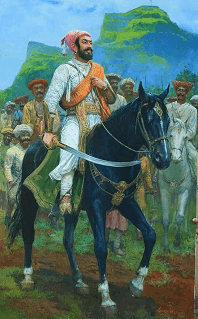
Due to Shivaji's disputes with the Bijapuri Sultanate and his unending victories, the Mughal Emperor Aurangzeb failed to notice him. Aurangzeb concentrated his efforts on eliminating the Maratha threat because he saw him as a threat to the spread of his highest goal. When Shivaji's army stormed and looted Mughal holdings near Ahmednagar and Junnar in 1957, conflicts erupted. Even so, Aurangzeb's counterattack was thwarted by the arrival of the stormy season and the struggle for advancement in Delhi. To stop Shivaji, Aurangzeb coordinated Shaista Khan, the governor of the Deccan and his maternal uncle. Shaista Khan sent off an enormous assault against Shivaji, catching a few fortresses under his influence and, surprisingly, his capital Poona. Shaista Khan was injured and expelled from Poona as a result of Shivaji's clandestine attack on him in response. Later, Shaista Khan planned many raids against Shivaji, significantly weakening his position in the Konkan region. Shivaji went after Surat, a prominent Mughal trading centre, and took from the Mughal treasures to replenish his depleted treasury. A furious Aurangzeb sent Jai Singh I, his central general, and a horde of 150,000 people. The Mughal empire inflicted severe damage by invading Shivaji's castles, stealing their treasure, and then slaughtering the defenders. To save any additional casualties, Shivaji agreed to reach an understanding with Aurangzeb. On June 11, 1665, Shivaji and Jai Singh ratified the Treaty of Purandar. Shivaji agreed to hand over 23 fortresses and pay the Mughal Empire 400,000 as compensation. Shivaji was welcomed by Aurangzeb in Agra with the intention of using his strategic skills to unite the Mughal domains in Afghanistan. With his eight-year-old son Sambhaji, Shivaji travelled to Agra. He was displeased with how Aurangzeb had treated him. He stormed out of court, and an indignant Aurangzeb imprisoned him at home. However, Shivaji eventually used his intelligence and cunning to escape the arrest. He pretended extreme ailment and set up containers of desserts to be shipped off sanctuary as contributions for supplication. On August 17, 1666, he escaped by disguising himself as one of the transporters and hiding his child inside one of the containers. In ensuing times, Mughal and Maratha threats were placated generally by consistent intercession through Mughal Sardar Jaswant Singh. Harmony endured till 1670, after which Shivaji jump-started a full-scale offence against the Mughals. He recuperated a large portion of his domains attacked by the Mughals in four months or less. Relationship with The EnglishShivaji had friendly connections with the English from the start of his rule, until they sided with the Bijapuri Sultanate in a conflict against him at the takeover of Fort of Panhala in 1660. As a result of their refusal to give him war supplies, Shivaji launched an attack on the English in Bombay in 1670. This dispute resumed in 1971, when the English once more refused to assist him in his attack on Danda-Rajpuri and he looted from the English manufacturing plants in Rajapur. Numerous attempts by the two to reach an agreement failed, and the English refused to lend a hand in his initiatives. Crowning Ceremony and Conquests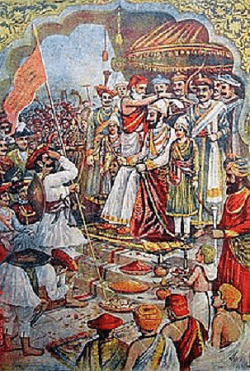
Subsequent to having solidified a significant command over domains connecting Poona and Konkan, Shivaji chose to take on a Kingly title and lay out the principal Hindu Sovereignty in the South, which was presently overwhelmed by Muslims. On June 6, 1674, in Raigadh, he was appointed the King of the Marathas after a complex crowning celebration ceremony. The Coronation was directed by Pandit Gaga Bhatt before a social event of around 50,000 individuals. He took upon a few titles like Chhatrapati (vital sovereign), Shakakarta (pioneer behind a time), Kshatriya Kulavantas (head of Kshatriyas) and Haindava Dharmodhhaarak (one who elevates the sacredness of Hinduism). After the royal feast, the Marathas, acting on Shivaji's orders, launched a series of aggressive coup attempts to unify the majority of the Deccan states under Hindu Sovereignty. Khandesh, Bijapur, Karwar, Kolkapur, Janjira, Ramnagar, and Belgaum were all defeated by him. He obtained positions at Vellore and Gingee under the restrictions of the Adil Shahi sultans. He likewise came to comprehension with his step-sibling Venkoji over his possessions over Tanjavur and Mysore. What he focused on was bringing together the Deccan states subject to a local Hindu ruler and safeguarding them from outcasts like the Muslims and Mughals. Military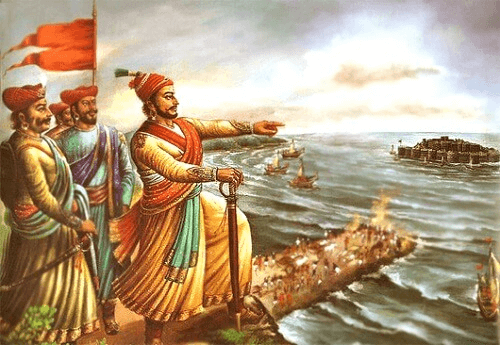
Shivaji showed extraordinary expertise in making his tactical association, which went on until the destruction of the Maratha Empire. His system laid on utilizing his ground powers, maritime powers, and a series of strongholds across his domain. The Maval infantry filled in as the centre of his ground powers (built up with Telangi musketeers from Karnataka), upheld by Maratha cavalry. His mounted guns were moderately immature and dependent on European providers, further slanting him to an exceptionally versatile type of fighting. Organization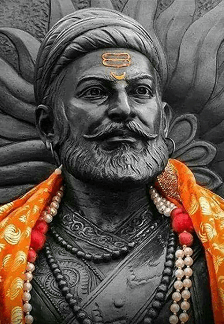
Under his rule, the Maratha organization was laid out where Chhatrapati was the preeminent sovereign, and a group of eight clergymen were designated to regulate the legitimate requirement of different strategies. These eight priests revealed straightforwardly to Shivaji and were given a ton of force as far as the execution of strategies formed by the King. These eight priests were -
Shivaji overwhelmingly advanced the utilization of Marathi and Sanskrit in his court rather than Persian, the current Royal language. To emphasise his Hindu rule, he even gave the castles that were under his control Sanskrit names. In spite of the fact that Shivaji himself was a faithful Hindu, he advanced the capacity to bear all religions subject to his authority. His regulatory arrangements were subject-accommodating and empathetic, and he energized the freedom of ladies in his rule. He was stringently against rank segregation and utilized individuals from all stations in his court. He presented the Ryotwari framework killing the requirement for mediators among ranchers and the state and gathering incomes straightforwardly from the makers. Shivaji presented the assortment of two assessments called the Chauth and Sardeshmukhi. He partitioned his realm into four regions, each headed by a Mamlatdar. The town was at the smallest organisational level, and Deshpande, who oversaw the Village Panchayat, was in charge of it. Shivaji kept areas of strength for power, constructed a few key posts to get his lines and fostered areas of strength for a presence along the Konkan and Goan coasts. Death and Legacy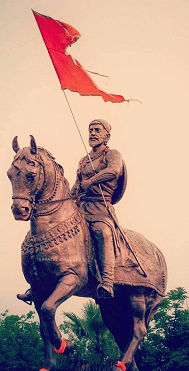
Shivaji Maharaj passed away at 52 on April 3, 1680, at the Raigad Fort, in the wake of experiencing an episode of looseness of the bowels. A contention of progression emerged after his passing between his oldest child Sambhaji and his third spouse Soyrabai for the benefit of her 10-year-old child Rajaram. Sambhaji ousted the youthful Rajaram and rose to the lofty position himself on June 20, 1680. the Mughal-Maratha clashes went on after Shivaji's passing, and the Maratha brilliance declined significantly. Anyway, it was recovered by youthful Madhavrao Peshwa, who recovered Maratha's greatness and laid out his position over North India.
Next TopicCharles Dickens
|
 For Videos Join Our Youtube Channel: Join Now
For Videos Join Our Youtube Channel: Join Now
Feedback
- Send your Feedback to [email protected]
Help Others, Please Share









